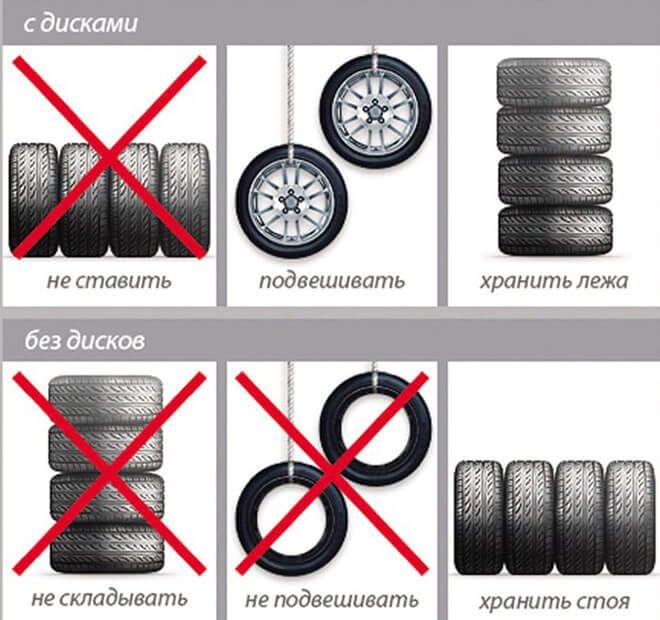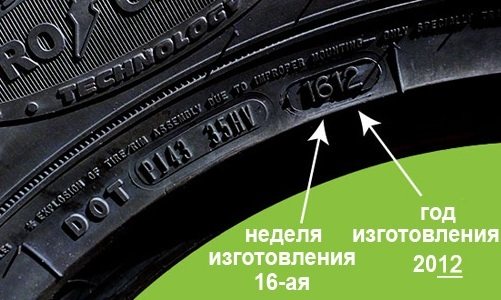Many car owners have heard about the fact that if the car has been idle for a long time, then it is necessary to change the rubber products on it, including tires. The fact is that tires have a limited shelf life. Over the years, rubber dries out and becomes unsuitable for performance. But this circumstance also applies to rubber that is used regularly. To make it easier for car owners to calculate the service life, manufacturers set the production date on their products. Thanks to this, the driver can determine the expiration date and decide on installation.
Tires that are unclaimed by customers and have been in the store's warehouse for 5 years are sent back to the factory for recycling.
According to GOST
The legislator has fixed the basic requirements for tires:
Dear readers! To solve your problem right now, get a free consultation
— contact the lawyer on duty in the online chat on the right or call: +7 (499) 938 6124 — Moscow and region.
+7 (812) 425 6761 — St. Petersburg and region. 8 (800) 350 8362 - Other regions of the Russian Federation You will not need to waste your time and nerves
- an experienced lawyer will solve all your problems!
- GOST 4754-97 “Pneumatic tires for passenger cars, their trailers, light trucks and especially low-capacity buses. Technical Specifications” provides a classification and explanation of markings, establishes an expiration date of 5 years from the date of manufacture.
- GOST 5513-97 “Pneumatic tires for trucks, their trailers, buses and trolleybuses. Technical conditions".
- GOST 52900-2007 “Pneumatic tires for passenger cars and trailers. Technical conditions".
Shelf life of tires
This is the period during which the manufacturer guarantees the preservation of the properties of the product, provided that the consumer complies with the maintenance rules. The end of the shelf life means that the appearance and quality of the product may deteriorate, but it can still be used for its intended purpose.
The material from which tires are made is subject to natural aging under the influence of chemical and physical processes. To prevent the loss of basic properties, special fillers are added to the polymer composition at the production stage, which prevent ozone destruction of rubbers. Such manipulations make it possible, with proper storage of the products, to ensure the performance qualities of a car tire at the level of a new one.
Important note: shelf life and guaranteed shelf life are different concepts. According to GOST, the minimum age of a tire is 5 years. This means that during this period the wheel tires must meet the stated technical characteristics. The manufacturer is responsible for his product, which is a guarantee for the buyer.
We recommend
“A tire goes flat on the rim: how to solve the problem” Read more
Recently, many experts from America have stated that a limit of 10 years should be set for the life and storage of car tires. European manufacturers insist on much shorter shelf life - up to 6 years. This restriction also applies to new products.
According to GOST 24779-81, pneumatic tires should be stored as follows:
- Tires should not come into contact with corrosive or copper substances. Prolonged one-sided loading, piling of products on top of each other, bends, and reliance on sharply protruding elements are also unacceptable.
- When storing and transporting rubber products, they should not be affected by ozone, acids, oxygen, light, heat, mineral oils, organic solvents, fuel, alkalis, lubricants.
- Car tires should be stored at a temperature range from 25 to 35 °C. They should not be exposed to direct sunlight at a humidity less than 80%, as well as thermal contact with the heater.
- Products intended for repairing a worn tire by replacing the worn out tread must be thoroughly washed and dried.
- The aging process can be significantly slowed down by storing tires in a dark and cool place. In a damp room with sudden temperature changes, car tires quickly lose their quality, elasticity and strength.
- When storing tires outside, they are raised above the ground, providing ventilation and free air flow, and covered with moisture-proof, opaque material.
- It is strictly forbidden to store car tires on wet, oily, or contaminated with petroleum products or gasoline surfaces.
- The storage location should be located away from open flame sources.
- Containers with solvents, fuel, chemicals, oils, acids, paint cans or disinfectants should not be placed near car tires.
- The ozone concentration level from sources that may be located near storage sites should not exceed 0.08 ppm.
- Do not store tires on surfaces that reflect (snow) or absorb (black soil) heat.
- The tire should not be used to store tools or as a work surface. It is forbidden to place a lit cigarette on it.
Car tires of such well-known brands as Bridgestone, Dunlop, Goodyear can serve their owners for more than 10 years. This expiration date is generally accepted in all countries. But German tires must be replaced with new ones within 5 years from the date of their release.
Although, again, the shelf life of car tires, both new and those that have served for more than one season, is greatly influenced by their storage conditions. For example, Finnish products must be replaced 3–5 years after 5 years of operation, subject to annual quality control.
Russian legislation does not establish the maximum possible shelf life for wheel tires, but experts believe that a tire that has been in a warehouse for 5 years fully retains the technical characteristics laid down by the manufacturer.
What is the expiration date of rubber?
The law establishes the standard period for wheel tires - 5 years. However, there is no strict ban on their further use, so many people sell, buy, and continue to drive on tires that have long since crossed this threshold.
Indeed, global companies producing rubber tires provide a guarantee for their products from 6 to 10 years. Therefore, the service life comes to the fore, when tires are able to maintain their properties and meet safety requirements.
IMPORTANT! The expiration date is calculated from the moment of production, not the start of use.
At the winter
Rubber for the cold season is softer, has a specific composition and service life. Its peculiarity is Velcro or studs, which are designed to improve traction and speed up braking.
The average service life indicated by manufacturers is 7 years under ideal operating and maintenance conditions. It is clear that given the Russian climate and roads it is impossible to ensure this, so using the same tires is permissible for a maximum of 3-4 seasons. It should be noted that Velcro will last a little longer.
At the summer
Summer tires vary by category. The composition, purpose, and wear resistance depend on it. It is logical to assume that tires for driving at high speeds over 200 km/h marked H, ZR are subject to greater loads and wear out faster.
For the safety of the car owner, it is strongly recommended to replace such tires after a maximum of 6 years. The same principle applies to large vehicles and trailers. They last a long time, have a low annual mileage, the treads may look decent without external damage, but this is not evidence of their reliability.
The permissible period of use of regular summer tires can be obtained from the manufacturer. Often, it is stated as a guarantee. In any case, using tires for more than 5 years is accompanied by a certain risk.
Therefore, it is especially dangerous to buy used tires. It is unknown how often it was used, maintained, stored, or whether it was properly cared for. Therefore, it is impossible to say exactly how long it will serve its new owner.
Additional features
Only the users themselves are responsible not only for the condition of the tires, but also for the operating conditions. Users themselves determine when the need for replacement arises.
Tires of passenger cars and minibuses must undergo regular inspection in special centers, where specialists will give recommendations on further maintenance. This applies not only to main products, but also to spare parts. It is recommended to have a professional diagnosis at least once a year. This will increase the service time.
Any changes in tire pressure or unusual behavior of the car on the road should alert you.
As a preventative measure, it is recommended to completely replace tires that were manufactured 10 or more years ago. Even if their appearance suggests that they are still suitable for use. This also applies to the spare wheel, even if extreme wear has not yet been reached.
If tires are included in the initial package with the car, you must follow the recommendations that it gives. This will make it easier to maintain service life.
Storage period for tires for cars without use

What is more important here is how they were stored all this time. When changing from summer to winter or vice versa, an unused set must be kept in appropriate conditions so that it will last for more than one season.
Storage conditions
If tires are stored without rims, they are placed on the tread. If on disks, they need to be hung or stacked on top of each other. To maintain elasticity, you will need to lubricate with a special tire care product.
Where is better
A warehouse without a source of direct sunlight, exposure to ozone, or mineral oils is ideal for this purpose. It should be well heated (from +10 to +35 °C), and the humidity should be maintained at a normal level (~ 80%).
Service life of passenger car and truck tires in accordance with regulatory documentation
Tires wear out not only due to operational loads. They are characterized by natural aging, since the rubber mixture from which the tires are made gradually loses its elasticity and resilience. The use of such tires leads to deterioration in vehicle controllability and creates hazardous conditions due to the high probability of a tire bursting on the road.
In accordance with GOSTs 4754-97 and 5513-97, the warranty service life of car tires is 5 years.
Foreign manufacturers claim that the service life of tires is 5-10 years. There are no legislative acts obliging drivers to change tires after this period, but in order to create safe driving conditions, the driver must take into account the recommendations of GOST. Manufacturers usually set their own warranty periods.
Table of warranty periods for tires of the Michelin, Bridgestone, Nokian, Continental, Dunlop, Pirelli, Yokohama brands "(Yokohama):
| Brand | Warranty expiration date stated by the manufacturer |
| Bridgestone | Depends on tire type – 3-6 years |
| Nokian | 5 years |
| Continental | 10 years |
| Dunlop | Depends on tire type |
| Pirelli | Depends on tire type |
| Yokohama | 5 years |
| Michelin | 10 years |
During the warranty period, responsibility for any significant defects identified lies with the manufacturer. The owner of the vehicle will be forced to independently eliminate defects if:
- violation of storage conditions for tires, as a result of which certain defects appeared on the products;
- installation on a disk that does not match the tire;
- deformation, corrosive wear and severe contamination of the rim;
- a combination of tires and tubes that do not correspond to the designations;
- unprofessional installation of tires;
- operating a tire with incorrect internal pressure;
- mechanical and chemical damage to tires;
- installation of tires with a tread depth less than the permissible level;
- lack of warranty card;
- installation on a vehicle with broken axle geometry or damaged suspension;
- use of tires that do not correspond to the season;
- preliminary repair of products.
If the vehicle is used intensively, the need to replace tires may occur before the expiration of the warranty period. Therefore, regulatory documents establish the amount of mileage after which you should think about replacing tires.
The maximum standard mileage is:
- for a passenger car with a carrying capacity of up to 2 tons – 45 thousand km;
- for freight vehicles with a carrying capacity of 2-4 tons – 60 thousand km;
- for cargo vehicles with a carrying capacity of over 4 tons – 65-70 thousand km.
Factors that affect tire performance
The most significant factors can be identified:
- The production date is always indicated on the rim.
- Storage conditions. If they are inappropriate, this threatens the formation of microcracks invisible to the eye. They gradually lead to the destruction of rubber.
- Mileage. Both daily driving and prolonged downtime are destructive.
- Pressure. To extend the life of tires, it is necessary to follow the manufacturer's recommendations for pressure levels, otherwise the life will be reduced by 15%.
- Driving faster than 120 km/h reduces the shelf life by half.
- Exceeding the permissible vehicle load. Constant overloads will reduce the tire use time by a third.
- Technical condition of the car. Some faults can lead to increased load on the tires.
Winter
For winter, in addition to the above factors, pressure is important. It should be 0.2 bar higher than recommended. Also in winter you need to carefully monitor the serviceability of the wheel alignment.
Summer
In summer, elevated road temperatures are detrimental to tires. Therefore, it is important not to delay the timely change of winter tires to summer tires.
How to check the degree of wear
You need to find out whether the tread is worn.
IMPORTANT! A residual height of 1.6 mm is considered critical.
But don't wait for this mark. It is better to use summer tires up to 2-3 mm, winter tires up to 4-6 mm. There are several methods for measurement:
- Visual inspection. Obvious damage will become visible: cuts, cracks. It is worth studying the wear indicator - a protrusion perpendicular to the axis of rotation. If it is equal to the tread height, it is time for replacement.
- Using a caliper or ruler. Measurements must be taken at ten points around the circumference, in the center, along the edges. By summarizing the data, one can judge the suitability.
How to increase the period of use of wheel tires
To extend the life of your car tires, you need to follow simple rules:
- Check pressure periodically. When there is a long road ahead, the weight of the car increases significantly; when using a trailer, the pressure must be slightly increased, otherwise the tires will sag and wear out faster under the weight of the car.
- Control suspension geometry. To do this, every month you need to undergo diagnostics of the chassis and steering. Failure to comply may result in uneven grinding.
- Store correctly.
- Don't speed.
- No need to drift.
Sellers' tricks
Often when selling, we can see tires neatly stacked on racks. However, before that, they traveled for a long, long time in a railway carriage, stacked in piles. Sellers, of course, won't tell you about this.
Next, imagine the situation that the summer season has ended, but there are still summer tires in the warehouse. What to do? After all, we need to make room for winter tires! Summer tires will simply be removed from the racks and thrown, at best, into the snow under a canopy. The same thing will happen with winter ones at the end of the season. This batch will then be sold at reduced prices at the beginning of the season as a new collection or new arrival.
In Europe, tires are stored for no more than five years. After this, they will be sent to Russia or other countries where, by law, the storage period is not so strictly regulated. This will usually also happen early in the season.
Refrain from buying winter tires before the start of winter or summer tires in early spring - it is quite possible that they will try to sell you an expired tire.
Tire marking

This is complete information about tires in one place. It is standard; dimensions, technological characteristics, and features are indicated on the side.
What to look for when purchasing
When purchasing, you need to look at the following characteristics:
- Is the type and size suitable for a particular car? These specs look like 195/65R15, where:
- 195 – profile width in millimeters;
- 65 – percentage ratio of profile height and width;
- R – radial cord;
- 15 – disk diameter in inches.
You can learn about the needs of a specific machine from technical documents.
- Speed and load. For example, 98W means: 98 – load per wheel (kg). W – maximum speed (km/h). Decodings are indicated in special tables common to the whole world.
- Brand, date of manufacture. After the manufacturer's letter designation there are four numbers - this is the week and year of manufacture.
- Seasonality. The summer one is marked with the image of the sun, the winter one – with snowflakes.
How to identify expired tires
You need to find the production date and add 5 years to it. You also need to stock up on measuring instruments and assess the degree of tread wear. The residual height of 2-3 mm will be critical for summer, and 4-6 mm for winter.
About Continental tires
These tires, as a rule, are not very rigid. Only a few models, not very common, are suitable for off-road driving. Summer tires have a profile with pronounced gutters, which allows you to confidently feel the road in rainy weather. On a good dry road, this helps to maintain a good speed and avoid skidding. However, with a sharp start, you should be wary of slipping.
Winter tires have sufficient studding and can be produced with or without gutters. Winter tires with gutters are great for driving when the weather thaws, or you can opt for all-season tires in mild winters. Well, those who live in northern latitudes and thaws are a rare occurrence there should choose tires without gutters and with a more “off-road” tread pattern.

When tires should not be used
For your own safety, it is better not to use:
- Tires that have served their service life for 5 years. This is especially true for winter tires and cases where the conditions for storing and caring for them are unknown.
- Operation beyond the permissible tread wear is prohibited.
- With uneven wear.
The law does not oblige car owners to change tires; this is a matter of personal responsibility to themselves and other areas of the road.
Dear readers! To solve your problem right now, get a free consultation
— contact the lawyer on duty in the online chat on the right or call: +7 (499) 938 6124 — Moscow and region.
+7 (812) 425 6761 — St. Petersburg and region. 8 (800) 350 8362 - Other regions of the Russian Federation You will not need to waste your time and nerves - an experienced lawyer will solve all your problems! Or describe the situation in the form below:
Tire storage standards
Everywhere, the standards in the automotive industry were set by the Americans. This is not surprising - remember the automobile empire of Henry Ford and the number of cars that he produced all over the world. The Germans from the Continental company are trying to follow this standard - after all, the lion's share of their products goes to the USA. And the shelf life of a tire according to the standards of the US Department of Transportation is quite defined - a tire can be stored for no more than five years if all storage conditions are met.

Russian standards only regulate the shelf life of tires outdoors - no more than one month, according to GOST R 54266-2010. In this case, storage conditions must also be observed. In a warehouse, subject to storage conditions, the shelf life is not limited.
How can you find out the year of manufacture?
Many will start looking for the year of manufacture in the form of a classic date - day, month, year. They won't find her anywhere. The tire release time is indicated in a different format - as a four-digit number. The first two digits indicate the week of release since the beginning of the year, and the last two indicate the year itself.

It is logical that the first two digits cannot be greater than 53. Tires produced before 2000 had a three-digit shelf life marking, where the last two digits are the last digit of the year.
This standard was set, again, by the US Department of Transportation. The numbers should be looked for closer to the inner diameter of the tire, almost near the rim. In size, these numbers will be approximately one and a half to two times smaller than those indicated by markings and pressure data.
How not to buy marriage
Pay attention to the geometry of the tire rim. It should be the correct round shape. You need to buy tires with a tape measure. Measure the inner diameter on both edges of the tire rim in the most “suspicious” places, but at least twice. If the difference between the larger and smaller values is more than 3 mm, ask for another tire.
You also need to measure the tire thickness along the inner diameter. If the difference is more than 3 mm, take another copy. Of course, the figure of 3 mm is quite average and also depends on the diameter of the wheel. But, in general, it covers the error of measuring the tire with a tape measure.
Before selling, tires are usually washed if they have been dirty. But deep in the profile, especially if the profile is “off-road”, old traces of pollution remain. Go over them with a brush and examine what's inside. If the brush smells like gasoline, solvent, or emits some other odor different from rubber, the tires have been doused with something. Get it from another store.
On winter tires it is also worth checking that all the studs are in place.











